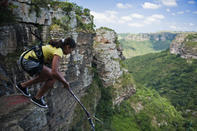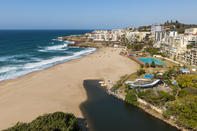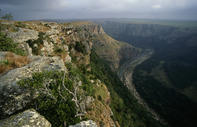When Justin Fox went exploring KwaZulu-Natal’s lower South Coast his expectations were overturned. . . dramatically. He met a Bavarian cowboy and his bar-fly pig, an Austrian who spent his days with hammerheads and a Congolese man selling plastic gorillas.
Adventures in the Deep South

It was not a good day to die. I looked at the world between my legs and saw the trajectory of my last moments traced by a rope. It was Hemingway – or rather his novels – who’d taught me that there are good days to die. But the clouds were ugly, the air sordid with humidity. I had hoped for a porcelain-blue sky and a late-afternoon stillness for my auspicious parting. But it was a dull morning when I stepped off the cliff and into the chasm.
What, you might ask, had brought me to this nightmarish moment of self-will? An exploration of the South Coast from Port Shepstone to Port Edward is the short answer. The long answer is that I was fascinated by what brought droves of holidaymakers back to a part of the coast others were so deprecating about. “Ooh no, dahling, not the South Coast - far too plebeian. Lemmings, dahling, they’re all lemmings.. . . ”
Golden Beaches

Gauteng by the sea, hellish humidity, over-exploitation, beaches for the masses, South Africa’s Costa do Sol. . . these were the conceptions handed down by some. But if the anti-utopian vision was correct, what on earth – I wondered – kept the visitors flocking?
After asking a few questions, another picture began to emerge: golden beaches fringed with palms and lapped by tepid Indian blue, the lushest golf courses in South Africa, tranquil estuaries loud with the call of myriad birds and sandstone gorges to take your breath away.
They had to be onto something. I was dammed if I wasn’t going to find out what. I packed my bags and set off to test the countervailing images of the sunscreen smearin’, banana-pickin’ Deep South.
Jason tightened the safety line and I concentrated on the cliff in front of me, not daring to look down at the figure 110 metres below. But once the initial stage fright had abated I began to enjoy what is reputedly the highest commercial abseil in the world. Oribi Gorge looked magnificent in semi-deciduous forest livery and the spray from Lehr’s Waterfall cooled me as I slid earthwards.
The minute I’d stamped the jelly from my legs, it was up the mossy cliff to the manager of Oribi-x-treme, Paul Jefferys, who whisked me back to my car. “With all the rain you won’t be able to do any white-water rafting on the Mzimkulu, but we’ve lined up a bit of surf rafting.”
Within the space of a few hours, I’d hit the waves for a rafting session with a bunch of lifesavers at Glenmore Beach and cruised the ocean off Port Shepstone spotting bottlenose dolphins. I was quickly learning that there’s more to the South Coast than factor 15 and colourful beach-umbrellas.
Series of Outdoor Adventures

Next on the adventure list was Braemar Trails near Port Edward. Here Leon Bondesio offers a series of outdoor adventures (by tractor, 4x4, mountain bike and foot) in and around the Umtamvuna Gorge. I chose the 4x4 option. After a drive through granadilla, macadamia nut and protea plantations we drew up at a cliff edge and there, far below us, gushed the swollen red of the Mtamvuna towards the sea, like a mighty haemorrhaging of the land. Beyond it, the old Transkei rolled away in green undulations.
“Apart from the amazing plant life – there are more than 1 250 indigenous flowering plants here – we’ve got some of the best birdwatching spots in the country,” said Leon. “There are Cape vultures nesting further up the gorge and some ‘lifers’ in the forest.” The two distinct forest types found in Southern Africa - Afro-montane and subtropical - overlap in this region, resulting in a bird list of nearly 400 species. For example, you can see east-coast specials such as the green coucal and golden-rumped tinker barbet in the same forest as the Afro-montane Knysna lourie and forest canary.
Magnificent Golf Courses
During my visit to the South Coast I stayed at a number of fine establishments, the most entertaining being San Lameer golf estate. There are no fewer than six magnificent golf courses between Port Shepstone and Port Edward. Spoilt for choice, I had settled for the what is arguable the prettiest.
Protea Hotel’s San Lameer (part of Sanlam’s vast development here) is set in a parkland par-72 golf course. I’m no golfing devotee, but this course is simply magnificent. It’s also a pleasure to be in an environment which is well-landscaped and has homogenous buildings (terracotta-coloured, Spanish-style villas). So much of the South African coast has been ruined by ad-hoc development.
I wanted to explore, thwack a ball, go paddling on the lagoon. But the rain was absolutely tipping down, so I twiddled my thumbs and the television remote, ate a leisurely snack at the pool-side restaurant and waited. A balding gent out from the ‘Youkay’ leant over to comment on the weather. “It’s all them Sputniks the Russians been sendin’ up,” confided Frank. “That’s why we’ve got so little ozone, and that’s why we’re gettin’ the floods.” I was fascinated.
When the first shaft of sun appeared I dashed to the clubhouse and managed to swing a club (watched by an appreciative bushbuck) with master caddy Eric Shashu.
The arc of my club was not as elegant as it should have been, but the tingling satisfaction of iron on ball was there, like an old friend. The dimpled spec bounded up the fairway and we followed in the cart, foot-flat to beat the deluge.
That night the rain set in with a vengeance, making a mockery of the distinction air, land and water. Mooi, my waiter, came over to commiserate. “Last week the river cut a hole 100 metres wide at Southbroom Beach,” he said.
When I told him about the article I was writing he was shocked. “Not the whole coast!? Yo, yo, yo, what a beeg job you have. And in all this rain,” he shook his head and poured me another G&T.
By Justin Fox